Pumpkins are such friendly looking gourds, aren’t they?
It’s hard not to smile when you see them adorning peoples’ porches in the fall.
But what’s even better is watching them grow into big, orange beauties in your garden.
There’s something even better than that, though: watching the pumpkins grow alongside their best companions, each plant providing a benefit to the others.
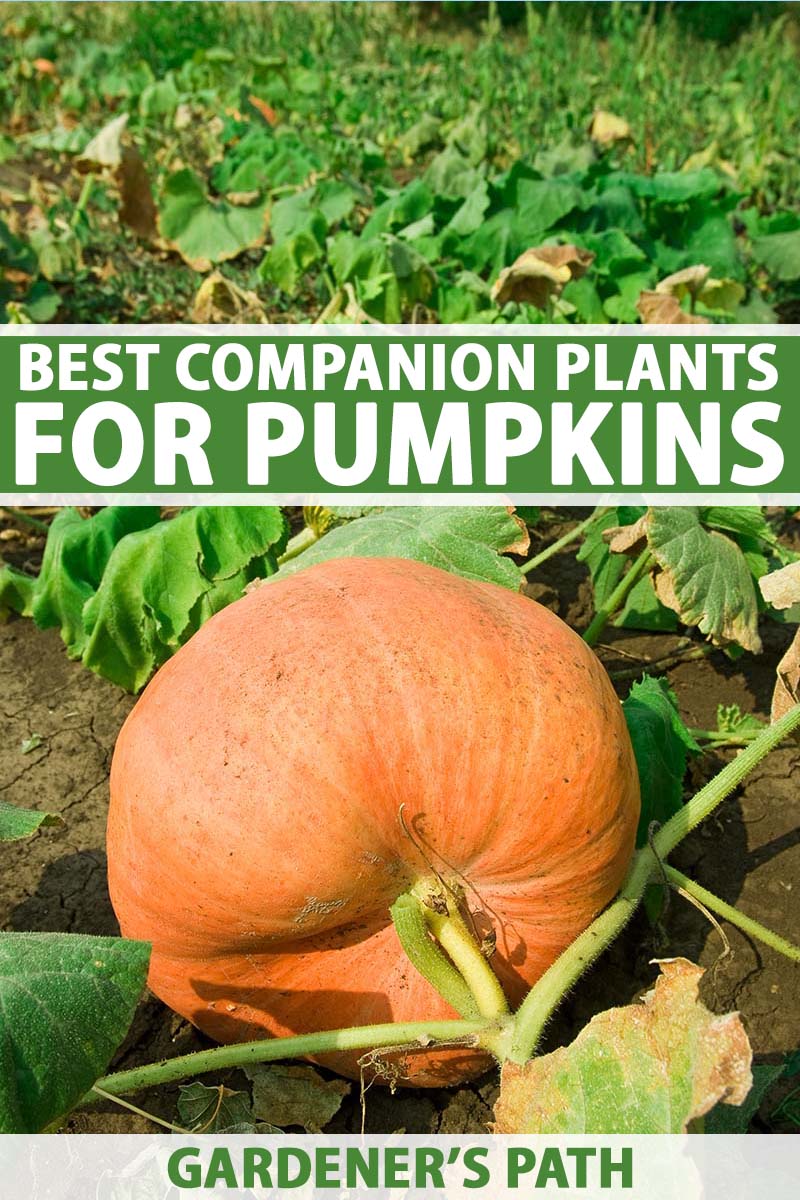
We link to vendors to help you find relevant products. If you buy from one of our links, we may earn a commission.
I bet you want to know which companion plants I’m talking about, yeah?
Okay. Let’s get started on making your garden into a joyful gathering of pumpkins and their dear friends.
What You’ll Learn
Why Pumpkins Need Companions
They’re big, they’re beautiful, and like people, pumpkins benefit from having companions nearby. Sometimes, placing friendly plants close together simply helps you save space in the garden.
I, for instance, have just two deep raised beds to work with. If I didn’t use companion planting, I wouldn’t be able to grow such a wide array of vegetables, fruits, and herbs.
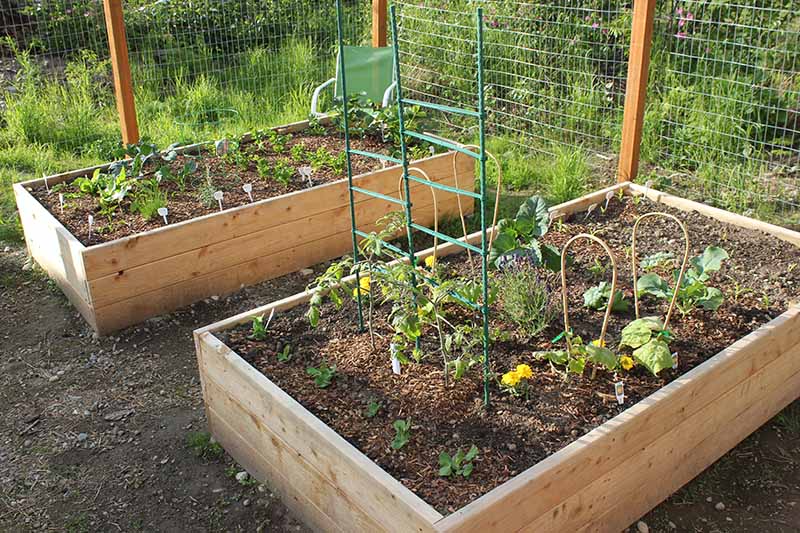
In addition, monocropping or filling an area with groups of the same vegetable serves as an open invitation to that plant’s most common pests to come hither and feast.
A cucumber beetle, for example, will spot a row of pumpkins and think it’s his luckiest day ever.
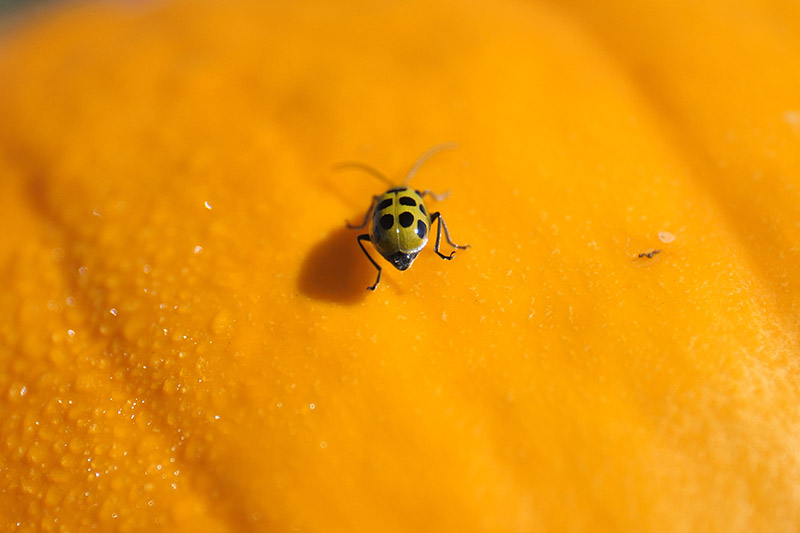
Since gourds are susceptible to attack from many pests – aphids, squash bugs, squash vine borers, and cucumber beetles, for example – it’s important to think about how to combat infestations.
Planting an array of pest-repelling flowers among your pumpkins can help to keep those bugs away. Plus, gardening legend has it that all the different colors – a sea of lavender, marigold, and nasturtium, for example – can serve to confuse potential pests.
Some companion plants will also act as trap crops, attracting the pests that might otherwise target your gourds. Some trap crop plants may even kill the pests they attract.
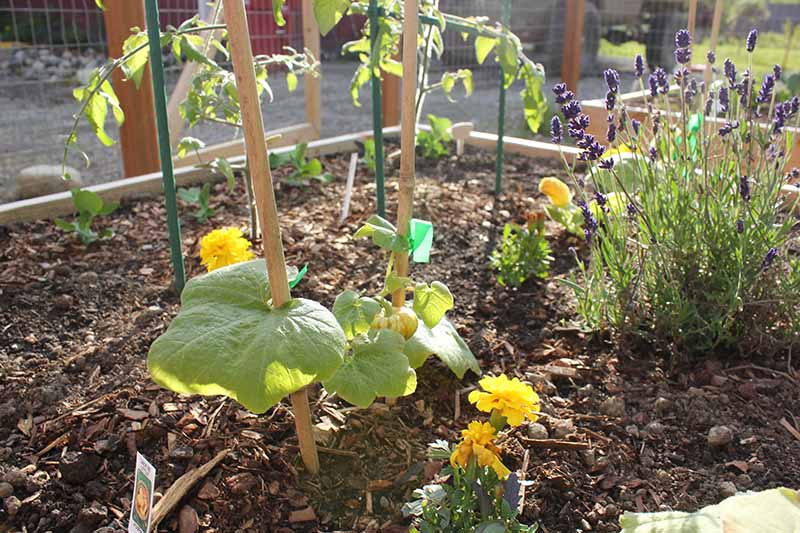
But companion planting doesn’t just save space and help protect your crop against pests.
Trailing pumpkin vines, with their large leaves, can act as a living mulch for crops with an upright growth habit, and help to keep their roots cool, and the soil moist.
Pumpkins are heavy feeders, and legumes such as beans and peas “fix” nitrogen, or add more of this essential plant nutrient to the soil.
Best of all, in my opinion: some companion plants, like lavender and sunflowers, also attract bees, which are important pollinators.
Ready to reap all these benefits for your gourds? Let’s go!
Pumpkin Companion Plants
These tasty summer annuals require companions who favor similar growing conditions.
Squash thrives in USDA Hardiness Zones 3-10 as long as you keep plants warm in cold weather, and provide some protection from excessive heat.
Choose the companion plants that best suit your environment, and you’ll be good to grow.
Let’s check out some of the best companions for your gourds:
1. Corn
Along with beans and squash, corn makes up the trio of perfect companion plants known as “The Three Sisters.”
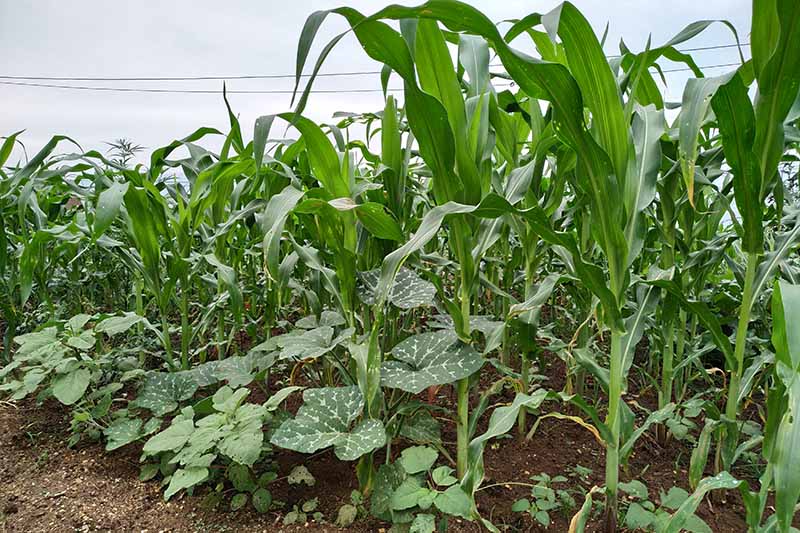
Early Native American peoples – including the Muscogee (Creek), Maya, and Haudenosaunee – planted these crops together to take advantage of their mutual benefits.
The vines will act as a groundcover and help to suppress weeds in the area around your corn. They will also help keep the moisture in the soil and prevent the roots from overheating.
The corn, in turn, provides a trellis for your pole beans, which will also fix nitrogen in the soil.
To plant the Three Sisters, sow corn first in mounds, often called hills, about three feet apart and the size of a small baseball pitcher’s mound.
Create two rows of hills, leaving two to four feet of space in between to plant your pumpkins. Space the corn seeds about four to five inches apart.
When the corn seedlings are six inches tall, you can plant pole beans around the corn. At the same time, sow your squash in the middle, in between the mounds.
‘Stowell’s Evergreen’ Sweet Corn
The best varieties of corn to plant in the Three Sisters method are large and sturdy – try the heirloom cultivar ‘Stowell’s Evergreen,’ a sweet corn that produces eight-inch ears.
Seeds are available from Eden Brothers.
You can read more about how to grow sweet corn in your garden here.
2. Korean Licorice Mint
Korean licorice mint, Agastache rugosa, attracts several types of beneficial hoverflies.
The hoverflies will lay their eggs on the leaves, and the larvae that hatch out love to feed on aphids, mealybugs, mites, and other pumpkin pests.
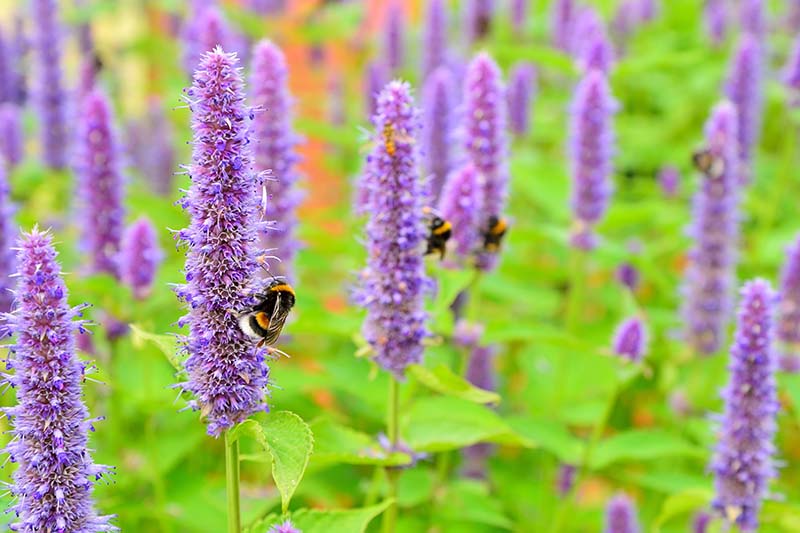
With vibrant blue-purple flowers, A. rugosa makes a decorative addition when planted around the outside of your vegetable garden.
This member of the mint family is also deer-resistant and heat tolerant, for those of you in warmer climes.
You can find A. rugosa ‘Little Adder’ plants available at Nature Hills Nursery.
Read more about growing anise hyssop and other types of Agastache here.
3. Lavender
This is my personal favorite companion plant for my pumpkins. And it’s one of my favorite herbs, hands down.
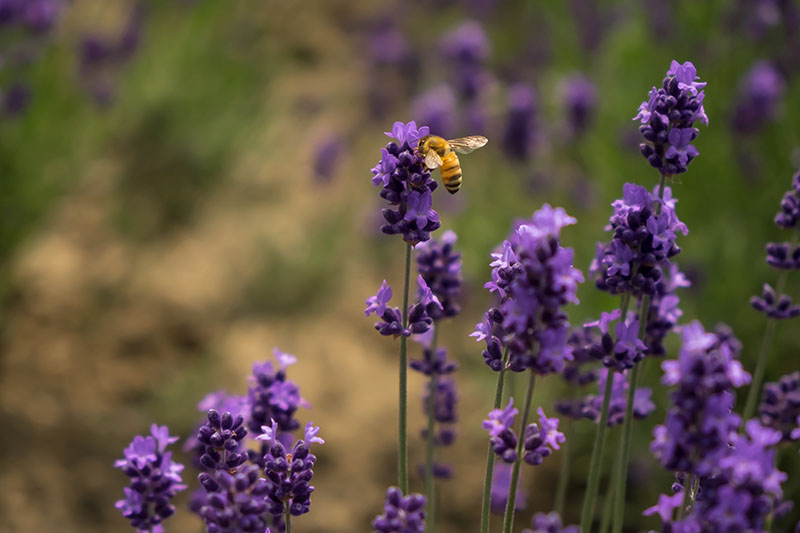
I use dried lavender seeds to fill my sleeping mask so that I can drift away to the sweet scent of lavender every night.
I plant it in my flowerbeds every year and try to keep it alive over the frigid Alaskan winter (one plant of three survived this last winter – a step up for me!).
And this winter, I’m going to grow it indoors from cuttings to enjoy those deep purple blooms and their divine scent all winter long.
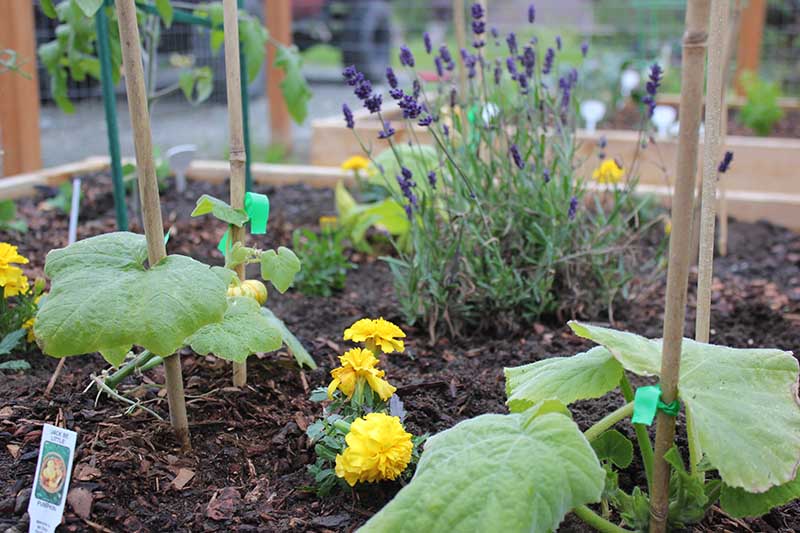
This year, I also planted English lavender smack-dab in the middle of my pumpkin patch.
I’ve already seen bees bumbling around the lavender, which means they are also bumbling around my squashes. Perfection!
That’s the benefit lavender provides for pumpkins: it helps attract bees, which are an important pollinator for these plants.
‘Hidcote Promise Compact’ Lavender
Find your own ‘Hidcote Promise Compact’ lavender seeds to plant with your gourds at Eden Brothers.
Learn more about how to grow lavender in the garden with this guide.
4. Marigolds
Often touted as a deterrent for a multitude of pests, the humble marigold isn’t quite as powerful as some might say.
But there is some truth to this popular piece of garden folklore.
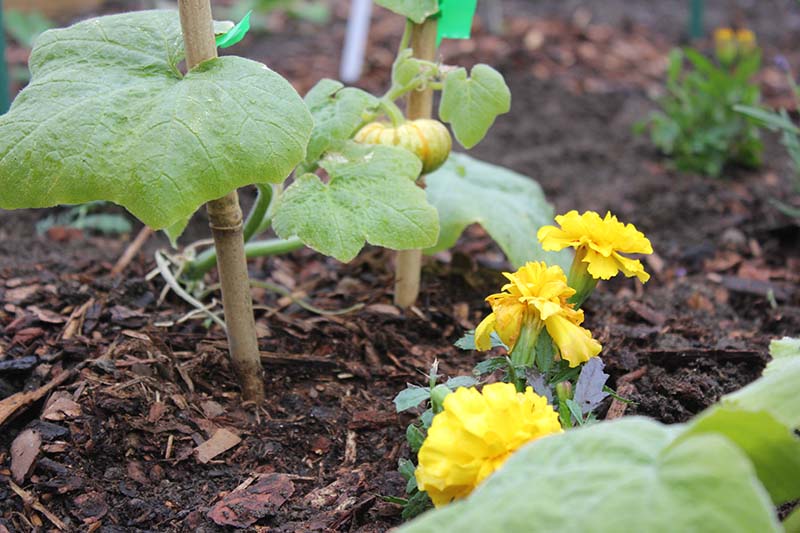
Marigolds may repel root-knot nematodes, harmful soil-borne pests that can damage your pumpkin crops, as their roots secrete bioactive chemicals that suppress roundworms.
Planting just about any variety of marigold next to your pumpkin plants will help keep the root-knot nematodes away. Plant them among the vines, as close as you like.
You can plant them as a cover crop, and till them into your garden at the end of the season to help improve the soil and keep it nematode-free.
You can find seeds for a specific variety called ‘Nema-Gone’ available at Burpee.
Check out our marigold growing guide here.
5. Marjoram
Not to be confused with its close cousin, oregano, marjoram tastes sweeter, with a lightly spicy, floral scent.
Growing this in your garden means you can enjoy a bevy of tasty dishes, like this fresh tomato, egg, and goat-cheese tart from our sister site, Foodal.
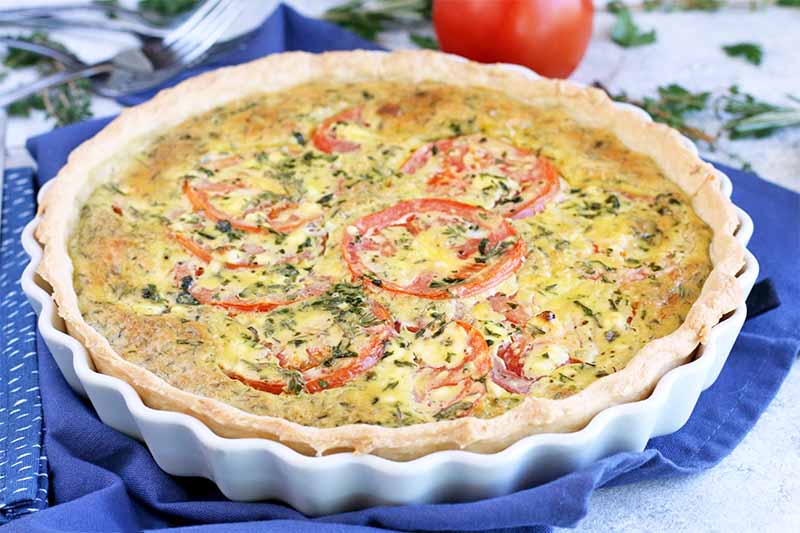
But it also can mean tastier pumpkin flesh. Garden legend has it that marjoram can improve the flavor of many veggies, pumpkins included, if the sweet herb is planted among the vines.
So not only will you enjoy fresh herbs for your cooking, but you may have more flavorful gourds as a result.
Find three marjoram plants or a packet of 2,000 seeds today at Burpee.
Learn how to plant and grow marjoram in this guide.
6. Nasturtiums
According to Louise Riotte, author of “Carrots Love Tomatoes,” available on Amazon, colorful nasturtiums help keep squash bug infestations down.
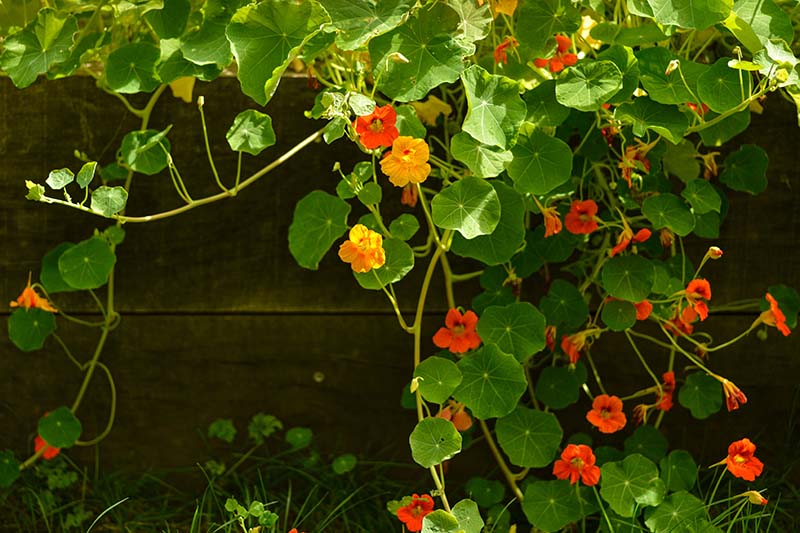
Considering that squash bugs may feed heavily on pumpkin vines and leaves, this is a definite plus.
Besides, you can toss peppery nasturtium flowers and leaves in a salad or simply enjoy the feast of color in your garden.
The plant also attracts the beneficial insects – such as ladybugs – that feed on common cucurbit pests, like cucumber beetles, aphids, and whiteflies.
In addition, they can act as a trap crop, attracting the aforementioned pests away from your pumpkins!
Plant compact nasturtiums in the middle of your patch, like the ‘Dwarf Apricot,’ available from Eden Brothers.
Read more about some of our favorite varieties of nasturtiums here.
7. Pole Beans
Along with corn and pumpkins, as mentioned above, pole beans are the third sister in the “Three Sisters” companion planting method.
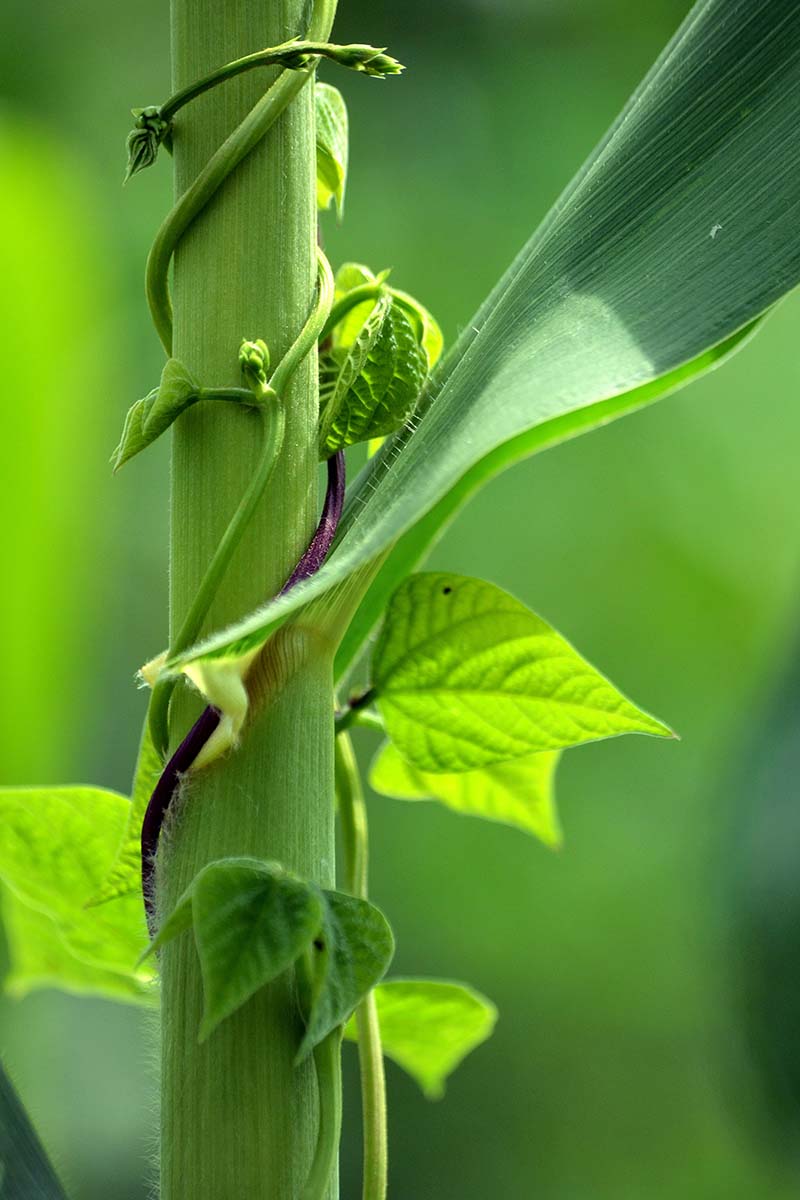
They benefit from the living mulch provided by squash vines and the trellis of a cornstalk, but they also add nitrogen to the soil.
Since pumpkins need nitrogen and Sister Corn absolutely guzzles it out of the soil, growing beans is helpful for next year’s crop.
Any legume can perform this beneficial task, but pole beans are ideal for the Three Sisters grouping because they climb up corn stalks, and save space in the garden.
You can find ‘Blue Lake’ pole bean seeds available at Eden Brothers.
Learn more about planting pole beans here.
8. Sunflowers
Often referred to as the Fourth Sister, sunflowers can attract pollinators to the pumpkin patch and help distract birds away from juicy corn kernels in a companion plant grouping.
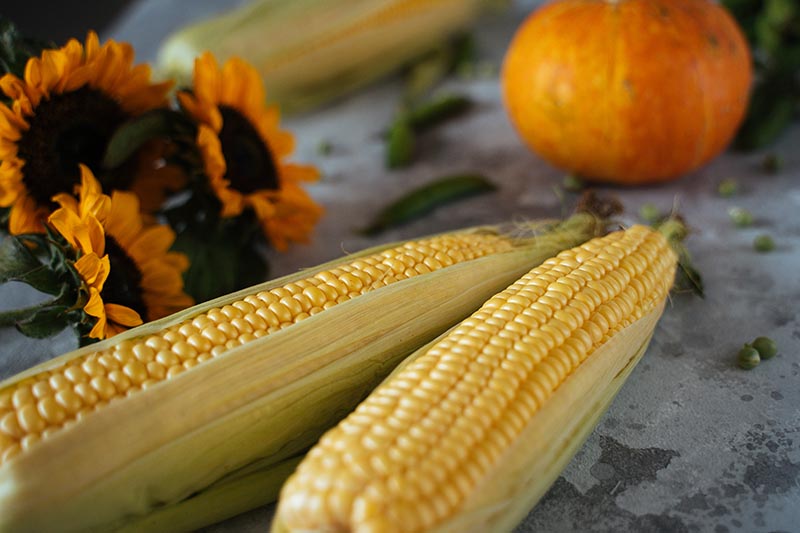
Next year, I’m going to try my hand at growing a Four Sisters garden with pole beans, corn, pumpkins, and sunflowers.
The pole beans can climb up the stems of the corn or the sunflowers.
The squash vines will provide a ground cover… It will be just gorgeous, don’t you think?
Find seeds for wild sunflowers available at Eden Brothers.
Check out our guide to growing sunflowers.
What Not to Plant with Pumpkins
Now that you know what you can plant alongside your gourds, let’s take a quick look at what not to sow near them.
First, you’ll want to avoid large root crops like potatoes, beets, and onions.

This is because the roots can disturb the shallow squash roots come harvest time, and compete for nutrients in the soil during the growing season.
If you must plant them in the same garden, make sure there’s plenty of space between plants, and consider selecting cultivars that are smaller at maturity.
Also, try not to crowd a bunch of vining plants together. It can get extra-tangly and confusing in your patch really quickly if you’re not careful.
They may also cross-pollinate with other cucurbits, which can be an issue if you’re trying to save seeds from your gourds to replant specific cultivars next season.
A Friend for Every Gourd
There’s such a lovely selection of plants you can grow alongside your gourds, don’t you think? If you need a refresher, check out our pumpkin growing guide.
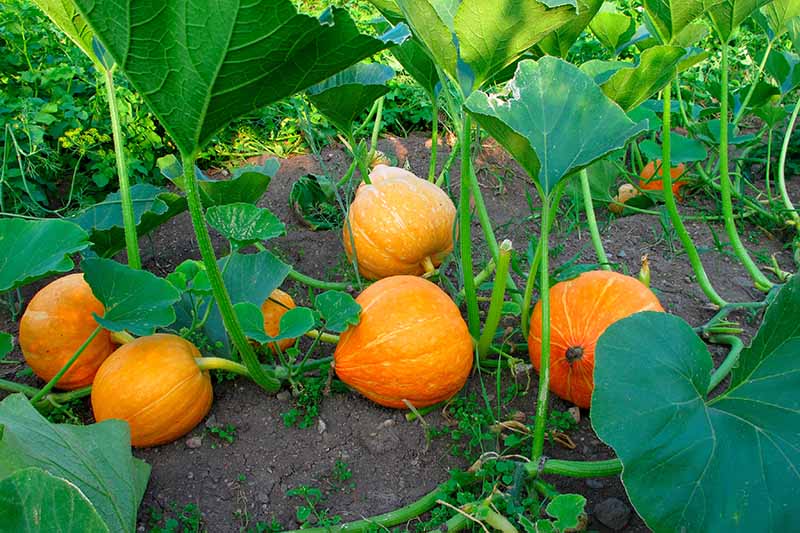
I’d love to know: which companion plant is your favorite when you’re growing gourds?
If you haven’t tried planting these beneficial friends alongside your pumpkins, which one would you like to try the most? Let me know in the comments below!
And in the meantime, for more information on growing pumpkins, check out these guides next:
- How to Choose the Best Halloween Pumpkins to Grow in Your Garden
- When and How to Trim Pumpkin Vines
- 11 of the Best Pumpkins for Pies, Puree, and Other Treats
- 5 Reasons Your Pumpkin Vine Isn’t Blooming
Photos by Laura Melchor © Ask the Experts, LLC. ALL RIGHTS RESERVED. See our TOS for more details. Product photos via Burpee, Eden Brothers, and Nature Hills Nursery. Uncredited photos: Shutterstock.
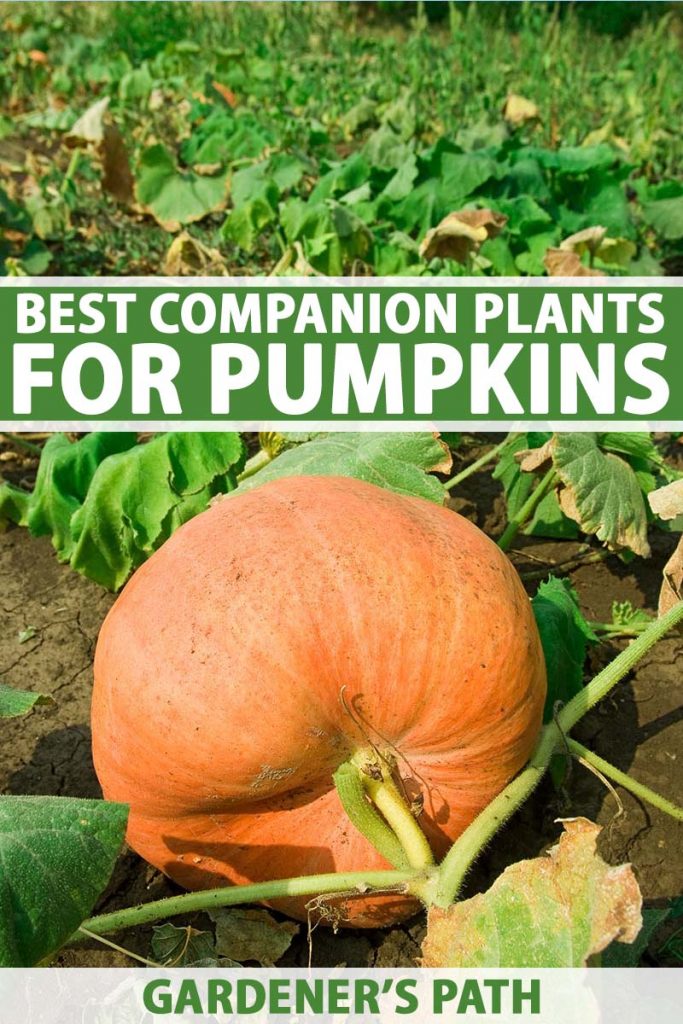
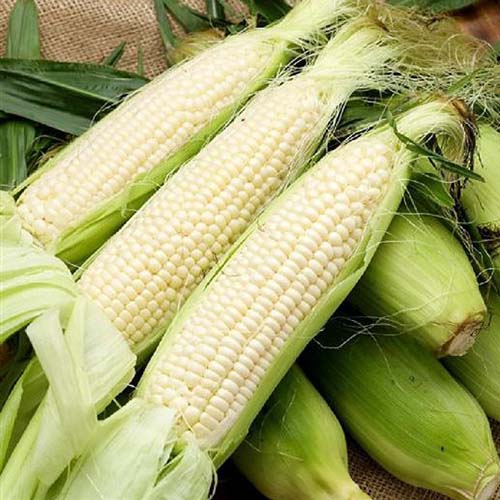


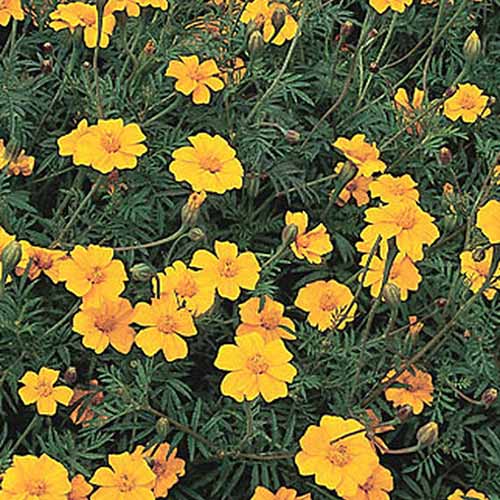
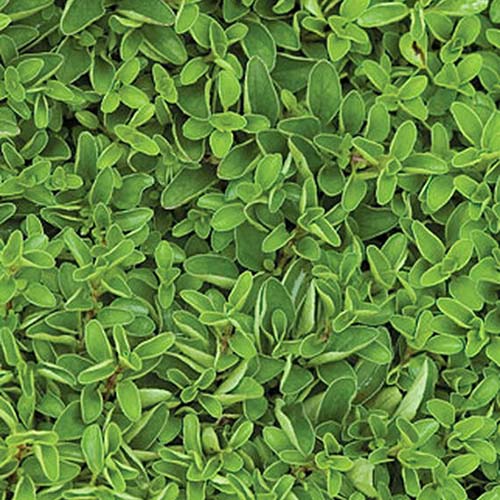
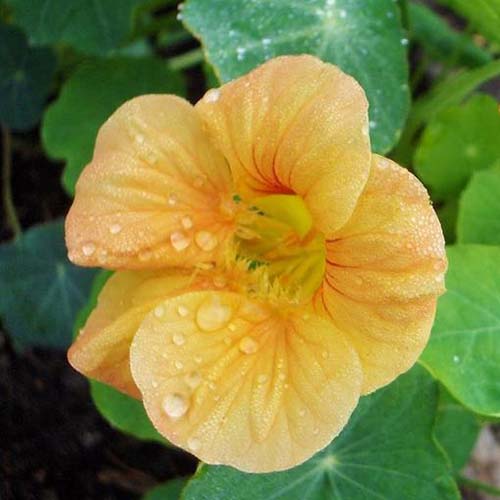
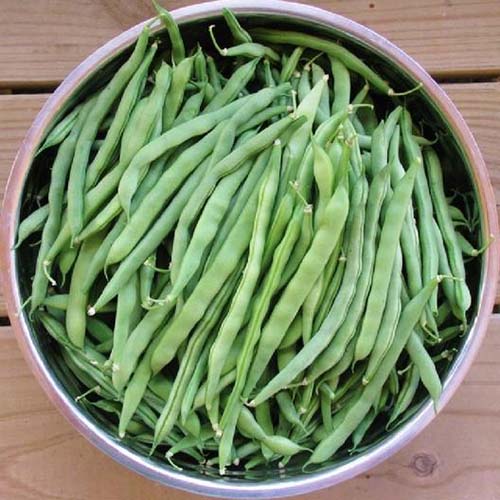
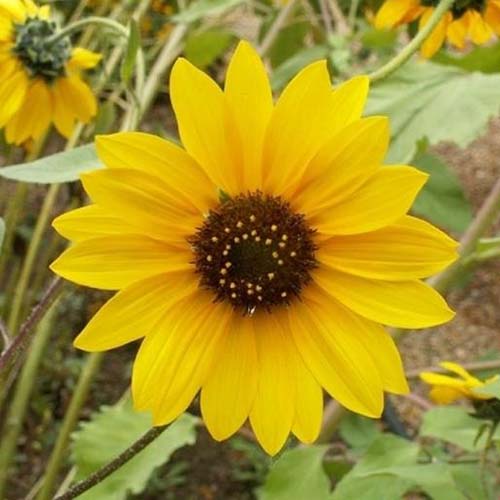
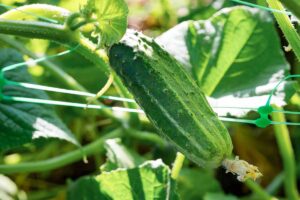
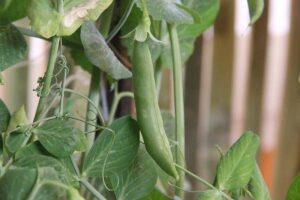
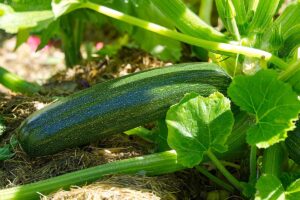
Oh my gosh! Thank you so much for these Awesome ideas for the 4 sisters! Cant wait to try this, we are in Michigan! Thank you also for putting the stores where to purchase! Will take photos this summer of my Awesome Pumpkin Patch! Thank you again, will be checking out other great ideas you have! Have a Great day!!
Thank you so much for your kind comment, Katheline! Let us know if you have any issues growing the 4 sisters! 🙂 (And we’d love to see photos of your success, too!)
lol it says avoid planting pumpkins near root crops potatoes, carrots, onions BEETS” then you scroll down and they have a photo of a large pumpkin sitting in a field of beets
Well, you CAN plant them near beets if you want. It all depends on how much tangling, root disruption, etc you’re prepared to deal with. ????
Thanks for the comment, you’re right, that picture is supposed to illustrate an overcrowded vegetable bed – it’s been moved into the correct section. Companion planting is part science and part trial and error, given that there are so many variables involved. Best practice is not to plant beets with pumpkins, but some people do so.
Gardening is a nice topic of conversation. 1/22. Out west we’ll soon be planting. Thanks for the reminders and ideas. Beans, maize & corn. Yes. Last year I tried Indian corn. I did a test planting in the fall. High germination rates. By spring the germination rates were only about 60%, down from 95% in the fall. I stored the seeds in the fridge. Could that have hurt the seeds?
Hi Ken! Did you use the same seeds for corn in the spring that you used in the fall? Corn seeds tend to spoil more quickly than other seeds, which is probably why there was a lower germination rate.
I love everything.
Thanks for reading, Paul!
The Korean Mint, Lavender, Pole Beans, Pumpkins might be a nice 4 some properly spaced in the garden area I have.
Hello Laura,
I just stumbled across your advice pages for pumpkin growing by chance, searching for guidance as we have just prepared a squash patch in our garden in the very North of England. Your suggestions on companion planting sound great.
If all is successful I will send you some pictures in due course.
With thanks
Stuart
I love these ideas! Thank you! So excited to make my pumpkin patch!
Hello! I have 2 deep raised beds, just like the beds in this article. My concern is that I have a pumpkin plant (Jack Be Little Pumpkin) in the same bed with sweet potato plants. There are many sweet potato plants but just 1 pumpkin plant. The Jack Be Little variety are the small/mini pumpkins. Is this going to be an issue?? I guess there isn’t much i can do about it now, but any info you can share will be helpful for future planning. 🙂 Thank you so much and happy gardening!
Hello Christy Sowell. The good news is that these two types of vegetables will not kill each other outright. The not-so-good news is that they do tend to compete for space and sunlight, which can be an issue. If you can, I would recommend training the ‘Jack Be Little’ up a trellis or at least propping a fence panel down its side of the raised bed to keep the vine off of the ground. You may not be aware that though the pumpkins it produces are tiny, the ‘Jack Be Little’ vines themselves can grow 10 feet long. Good luck… Read more »